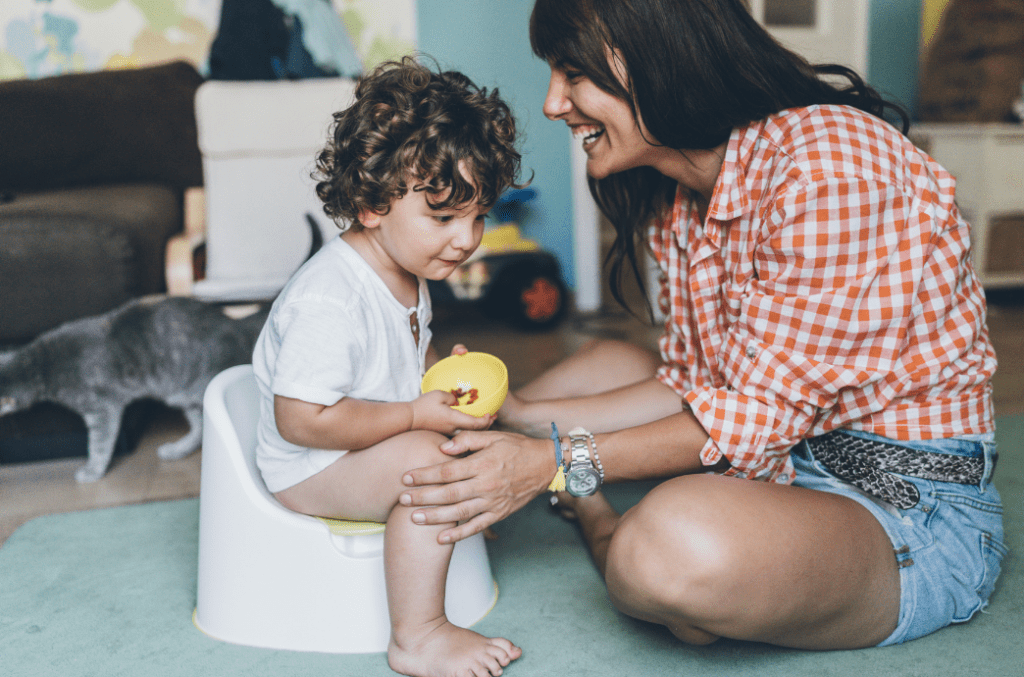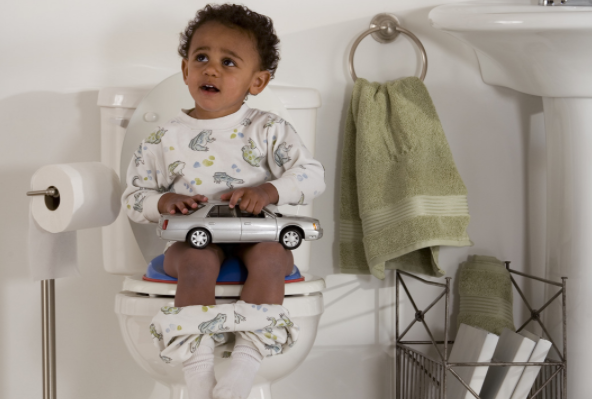Potty Training Tips from a Pediatric Pelvic Health Physical Therapist

6 Potty Training Tips
Potty training can be a trip. Every child is different. Every family is different. AND, there are SO MANY different opinions out there on how to do it best. Where do you even begin?!
This article will be a great place to start your journey. It is not intended to provide you with yet another method on how to toilet train your child. Rather, you will receive tips and tricks to start you and your child off on the right foot on your potty training journey. Let’s get started!
Tip #1: Use a Child-sized Training Potty
In a child-sized potty, the smaller size seat is helpful for putting your child’s hips and pelvis into an optimal position for going to the bathroom. Their knees are higher than their hips, knees are out to the side, and feet are flat on the floor. Having your child in the optimal position for going to the bathroom will set them up for success early on!
Another benefit is that your child will not be required to climb onto the big kid toilet and therefore will feel more supported on the ground and more likely to relax their pelvic floor muscles to allow the pee/poop to come out. Lastly, the age of potty training success is lower for families that have used a training toilet. If quick success is your goal, this is probably the choice for you!
Tip #2: It takes Time to Learn
It usually takes up to 6 months before your child will be fully toilet trained. This means, it is normal for children to still have sporadic accidents until 6 months after potty training.
This tip is helpful for many families who are frustrated that 3-4 months after being potty trained, their little one is still having some accidents without warning. If accidents last longer than 6 months, it may be beneficial to talk to a pediatric pelvic health physical therapist to be sure that your child is on track for full continence soon.
Tip #3: Breathing is important
Many children learn to be successful on the toilet by bearing down or forcefully pushing out their poop and pee. However, bearing down usually involves breath holding. By holding their breath, your child is putting an unnecessary amount of force through the abdominal cavity and pelvic floor. It could mean that your child is struggling to coordinate their breath control, pressures in their belly, and relaxation of the pelvic floor.
Try having your child sing a song while going to the bathroom or encourage them to blow bubbles to improve their coordination of breathing, pressures, and their pelvic floor. If you are struggling to get your child to breathe while toileting, it may be time to consult with a pediatric pelvic health physical therapist.
Tip #4: Skip the Pull-ups
Believe it or not, families that go straight from diapers to underwear tend to have greater success. This tip, in fact, comes directly from the American Academy of Pediatrics recommendation list. Why? The major benefit of potty training with underwear instead of pull-ups is that your child will quickly learn the feeling of being wet if they have an accident.
Since diapers and pull ups are very effective at soaking up urine, your toddler may get confused about what it feels like when they’re going to the bathroom vs. when they’re not. Because accidents will be more obvious to the child (and to you) it will be much easier to use each accident as a timely learning experience. This tip of switching from diapers straight to underwear is also recommended for children with developmental delays!
Tip #5: Sit on the Potty – A Lot!
In the initial phases of potty training, it is helpful to use a frequent sitting schedule to achieve initial success. Sitting on the toilet more often will encourage more initial successes, which gives more opportunities early on to celebrate the pee pee that is now in the toilet! To help this along, it can be useful to offer a lot of fluids in the initial few days of potty training in order to increase the frequency of your child’s success and frankly, just the amount of times that they will need to go.
Just know, that our bladders are not supposed to be emptying every 30 minutes. In fact, the bladder capacity of a 2-3-year-old should allow for the child to hold their urine for about 2-3 hours once toilet trained. If your child is going to the bathroom more than 2 times in a 4 hour period, it may be time to talk to a pediatric pelvic health physical therapist.
Tip #6: Have Fun!
It is important that your child is having a positive experience as you venture on this journey together. Involve them in the process by asking them what they’d like to earn for going pee pee or poop in the toilet. Perhaps it is a special snack or maybe they get to watch a video clip of their favorite song. Whatever it is, make sure that activity is immediately following the success.
This might mean having a stash of fruit snacks on top of the bathroom cabinet or pulling out your cell phone before they even get off the toilet. Smile with your child, let them know you’re happy, and keep the experience both positive and fun! Even if your child doesn’t have success in the bathroom, but they’ve happily gone to sit and try, reward this as well.
Use a smaller incentive for sitting on the potty without success, so that you can award their good efforts on a smaller scale. This is a sure-fire way to keep your child interested and motivated throughout the process.
Still Having Trouble?
Have you tried all of these tips and are still having trouble? That is okay! Some children need a few more months to mature before getting this process started. If you’re wondering if your child is even ready for toilet training, check out our 9 Signs Your Child Is Ready for Toilet Training blog.
If you’ve read these tips and are specifically concerned that your child is still not physically ready to potty train, please contact our office at 773-687-9241 to get scheduled for a pediatric pelvic health physical therapy evaluation at Chicago Pediatric Therapy & Wellness Center with Amanda DiGangi, PT, DPT, PCS. Amanda is a pediatric pelvic health physical therapist who is passionate about providing children with the foundational skills to maximize toileting success throughout development.











